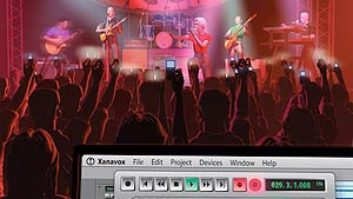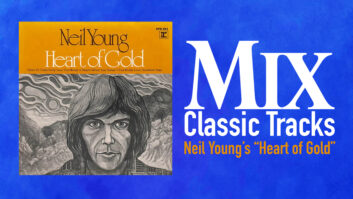Neil Diamond’s 2005 world tour started “down under” last March, played the UK in May, began its North American run last summer and will continue with more dates (TBA) in 2006. Diamond, who gave the Rolling Stones, Paul McCartney and U2 a run for their money, has never been known to take the predictable route. Though he had a new release to promote (12 Songs), his set list bucks the trend of “plug the new album” touring, and the list of audio “firsts” cited by Stan Miller, Diamond’s longtime concert sound designer/front-of-house engineer, could fill a page.
Miller was an early proponent of the benefits of digital consoles and mix automation in touring applications. He took the Yamaha PM1D console on its first major tour, and before that used a modular system of 01V mixers. On this outing, both FOH and monitors are based around Yamaha’s PM5D, using outboard AD8HR mic preamps instead of onboard RH head amps, with DM64N mix engines as splitters.
Digital submixes from both keyboardists, two guitarists and the bassist come from individual Yamaha 01V mixers. Another 01V mixes the talkback system, with inputs coming largely from Audio-Technica ATM35 clip-on mics at each musician’s position.
Monitor engineer Bernie Becker uses an Aardvark word clock generator and a Lucid word clock distribution amp to ensure stability among all digital systems. With nearly as many lines carrying AES or word clock as handling analog signals, the copper snakes, sub-snakes and XLRs were built with digital-rated wire, which, according to Becker, improves the quality of analog transmissions.
All musicians have Aviom A-16CS personal mixers to control their in-ear mix. “It certainly makes it nice for the band,” Becker says. “I spend 110 percent of my time looking at just one guy.” The tour uses Shure PSM700 and PSM600 transmitters, including one used for a wireless feed to the press mult. Diamond uses Sensaphonic two-ways, while the rest of the band uses mostly Etymotics with a mix of custom molds and foam tips; a couple performers use Future Sonics and Precision Labs. Diamond’s in-ear mix employs an Avalon VT-747 and an SPL DynaMaxx compressor/limiter.
Becker is also the live recording engineer, using 64 tracks of Pro Tools|HD running from a Magma PCI expansion chassis with Digidesign 192 I/O interfaces. Ambience mics are three Crown SASS-Ps across the front of the stage, a couple of AT-897 shotguns at each side and a pair of AKG C 747 mics from the downstage truss. Diamond tour veteran Greg “Chico” Lopez assists on monitors.
Other than the SM57 used on snare, wired mics are nearly all Audio-Technica, with ATM35s for toms and percussion, an ATM25 for kick, a 4051 pencil condenser for hi-hats and two 4033s for overheads. The four-piece horn section (trumpet, trombone, tenor and baritone sax) uses ATM4055 vocal mics. Wireless mics for Diamond and his background singers are Shure UHF with Beta 87 capsules. Lonnie Wayne checks frequency coordination with a WiNRadio analyzer and assists at FOH.
At the Yamaha PM5D, sitting (L-R): Bernie Becker and Stan Miller. Standing (L-R): Art Isaacs, Lonnie Wayne, Greg Lopez, Fumi Okazaki and John Drane
Photo: Yamaha Commercial Audio Systems Division
Miller’s FOH mix position has been simplified, with nearly all processing done within the PM5D, but there are still three computer screens on his right: an Apple laptop for the Pro Tools 002 interface providing walk-in music, a Dell for Smaart Live and a Sahara iTablet for wireless Lake Controller and Crown IQ software, operated by senior system engineer John Drane. Besides the drive rack, the only outboard FOH processing is the dbx 120 Subharmonic Synth. Five Lake Mesas are fed digitally from the PM5D. The sixth is a spare, with an analog input from an FOH Aviom mixer feeding the other five, with analog as backup.
While the “universal package” was leased from Maryland Sound, it’s now owned by Diamond’s Arch Angel corporation. Racks and stacks are provided by Maryland Sound. Art Isaacs assists with flying the system and rides herd on amp world. The MSI stacks are powered by a dozen racks of Crown iTech 6000s on each side of the stage. Each rack has an ATI reclocking digital distro amp, with speaker management performed by the iTech’s onboard 32-bit floating DSP. Miller notes that their frequency response differed from an analog drive system, necessitating the re-creation of VerTec presets. Sam Helms of Sigmet Corp. provided hours of testing time to “get the system presets right.”
Diamond’s arena show employs 16-box left/right main arrays of JBL VerTec VT-4889 cabinets with adjacent eight-box VT4890A sub arrays and 14-box 4889s covering the outsides. (This sold-out show is seated all the way behind the stage.) Twelve-box arrays of the smaller 4888 cabinets cover each side and two eight-box arrays cover the rear. Two more pairs are flown as sidefills to cover the stage. Individual 4887 compact enclosures are used across the front, with an additional one off the stage corner to hit the gap under the mains. A center cluster of six 4888s is used just for Diamond’s vocal.
Lighting designer Marilyn Lowey teamed with Miller to create the downstage arena truss design: a “v” shape, angled to clear the main speaker arrays, while leaving a gap for the center cluster. The Diamond crew is the epitome of professionalism clear down to “third man” Fumi Okazaki, an industry legend for efficiently doing the work of several normal stage techs.
Mark Frink is Mix’s sound reinforcement editor.





